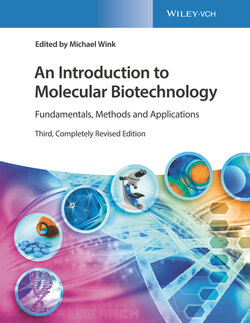Читать книгу An Introduction to Molecular Biotechnology - Группа авторов - Страница 29
3.1.5 Cytoskeleton
ОглавлениеThe cytoplasm is by no means an unstructured, soup‐like fluid. It contains a complex network of thread‐shaped proteins, which are part of the cytoskeleton. These networks that can be made visible using antibodies coupled to a fluorescent dye or by electron microscopy. Also cell lines exist, which express tubulin or actin coupled to green fluorescent protein (GFP); thus the dynamics of the cytoskeleton can be directly studied under a fluorescence microscope (Chapter 19). The structural proteins are often connected to the cytoplasmic membrane or cellular organelles:
Actin filaments
Intermediary filaments
Microtubules
The most subtle filaments are the actin filaments (F actin) (Figure 3.24), consisting of G actin monomers. Actin filaments have a plus and a minus end. ATP favors the elongation of actin chains. Actin filaments are interconnected by a multitude of connecting and anchoring proteins. They are also in close contact with various membranes. When the cell crawls, they form lamellipodia and filopodia; strings of actin support these structures. The interaction of cytoskeletal proteins is particularly complex in muscle cells. The best studied cells are striated muscle cells. A single muscle fiber that has merged from several cells, thus containing several nuclei, contains many myofibrils. In these myofibrils, actin and myosin filaments cooperate, forming a highly organized nanomachine. Any contraction of a muscle is the result of highly coordinated interaction between actin filaments and myosin (Figure 3.25).
Figure 3.24 Schematic composition of actin filaments (microfilaments).
Figure 3.25 Mechanism of muscle contraction. (a) Molecular mechanism of muscle contraction.
Source: Voet et al. (2016). Adapted with permission of John Wiley and Sons.
(b) Contraction of myofibrils; the thin filaments are actin filaments, the thick filaments consist of myosin.
Source: Courtesy of Hugh Huxley, Brandeis University.
The thickness of intermediary filaments lies in the middle between actin filaments and microtubules. Their main task is to stabilize the cell. The filaments are interconnected with many other proteins to create complex networks that are firmly anchored to the cytoplasmic membrane.
The thickest filament in the cytoskeleton are the microtubules, which form hollow tube systems and may be looked at as polymers of tubulin dimers (α‐ and β‐tubulin) (Figure 3.26). Microtubules have a plus and a minus end. GTP favors the growth of microtubules; GDP lets it shrink. Microtubules play a special part in the intracellular transport of vesicles. During cell division, they form the spindle apparatus that transfers chromosomes into the daughter cells. During the metaphase, the condensed chromosomes line up along the equatorial plate of the cell (Figure 4.7). The microtubules bind to the centromeres of the chromatids (Figure 4.4) and pull them into the new daughter cells. The microtubules extend from polar‐bound centrioles.
Figure 3.26 Schematic view of microtubules and cilia structures. Tubulin dimers bind to GTP and then polymerize to form protofilaments. Thirteen protofilaments are required to form a microtubule. Cilia and flagella are composed of 9 + 2 microtubules.
Flagella and cilia contain microtubules as supramolecular complexes (9 + 2 structure, Figure 3.26). Contact between two neighboring microtubules is mediated by dynein. The movement of microtubules against each other causes the cilia to bend, which, in turn, makes them move.
In cancer treatment, microtubules are important target structures for chemotherapeutics. The Vinca alkaloids vinblastine and vincristine or colchicine inhibit the polymerization of tubulin dimers, which form microtubules. By contrast, taxol or paclitaxel derived from the yew tree stabilizes microtubules and prevents their depolymerization. Also, actin and actin filaments serve as targets for some toxins. Phalloidin (one of the toxins from the deadly Amanita phalloides) binds to actin filaments and stabilizes them. Cytochalasin B (a mycotoxin) caps the plus site of actin filaments, swinholide (from a sponge) severs actin filaments, and latrunculin (also from a marine sponge) inhibits polymerization G actin into actin filaments.
Cytoskeletal filaments form complex networks while also providing a matrix that organizes the other organelles and multienzyme complexes within the cell. Complex regulation mechanisms control the buildup and breakdown of cytoskeletal elements. ATP‐consuming reactions (i.e. phosphorylation and dephosphorylation) and microtubule‐binding proteins play an important part in the process (e.g. microtubule‐associated proteins).
